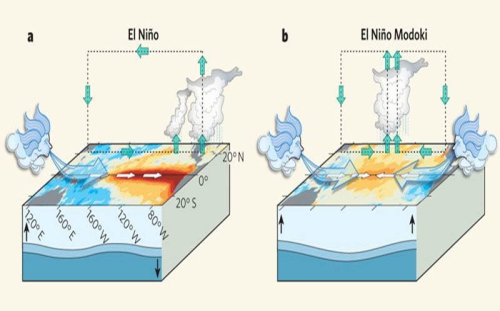With the more frequent occurrence of the central Pacific (CP) type of El Niño since the turn of the 21st century, the existing theories of ENSO (El Niño–Southern Oscillation) mechanisms, as well as our ability to predict ENSO, face severe challenges. Hence, since the concept of CP El Niño was put forward, it has drawn broad attention among scientific researchers. However, the physical mechanisms of CP ENSO are still not fully understood, and simulating it tends to yield grave defects, even in state-of-the-art general circulation models (GCMs). Owing to the complexity of the physical processes and parameters included in GCMs, it is hard to find ways to directly improve the situation.
Dr. FANG Xianghui, from Fudan University, and Prof. ZHENG Fei, from the Institute of Atmospheric Physics, used a simple linear air–sea coupled model (GMODEL), which can accurately depict the strength distribution of the thermocline (TH) and zonal advective (ZA) feedbacks in the equatorial Pacific, to investigate the two types of ENSO. Their findings, published in Advances in Atmospheric Sciences show that the model can reproduce the main characteristics of CP ENSO if the TH feedback is switched off and the ZA feedback is retained as the only positive feedback, confirming the dominant role played by ZA feedback in the development of CP ENSO. Further experiments indicated that, through a simple nonlinear control approach, many ENSO characteristics, including the existence of both CP and EP El Niño and the asymmetries between El Niño and La Niña, can be successfully captured using the simple linear air–sea coupled model.

Schematic diagrams of the (a) EP (eastern Pacific) and (b) CP (central Pacific) types of El Niño (also referred to as El Niño Modoki). The maximum sea surface temperature anomalies are in the EP during EP El Niño, whereas they are concentrated in the CP during CP El Niño [figure adapted from Ashok et al. (2009)].
"These analyses indicate that an accurate depiction of the climatological sea surface temperature distribution and the related ZA feedback, which are the subject of severe biases in GCMs, is very important in simulating a realistic CP El Niño,” argues Dr. FANG Xianghui .
References
Fang, X. H., and F. Zheng, 2018: Simulating eastern- and central-Pacific type ENSO using a simple coupled model. Adv. Atmos. Sci., 35(6), https://doi.org/10.1007/s00376-017-7209-9
Contact: LIN Zheng, jennylin@mail.iap.ac.cn
